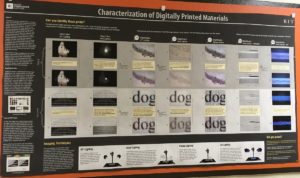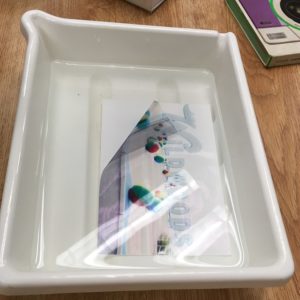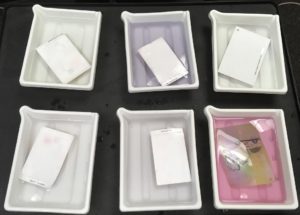Digital Print Crash Course

For 3 days in late October I joined a group of 15 conservation and archive professionals from as far away as Germany, Mexico City and the Northwest Territories of Canada for the “Identification and Preservation of Digital Prints” workshop at the Image Permanence Institute (IPI) at the Rochester Institute of Technology.
We learned about what curators might consider to be digital prints, what types of digital prints can be found within a collection, what their greatest vulnerabilities are, and how to differentiate between them. The workshop focused predominantly on the three most common types of digital prints: dye-sublimation prints, created through a process which uses heat to impregnate a surface with color; electrophotographic prints, which use toner-based colorants; and inkjet prints. We also discussed the best types of enclosures for storage, and how to use naming conventions to help collection curators and conservators identify these objects so as to best house, store, conserve and exhibit them.
Dye-sublimation prints are the least common of the three main types. The analog version of the process was invented for the textile industry and the digital version continues to be used to print images on fabrics as well as photo gifts like mugs. It doesn’t require liquid chemicals so it’s also popular for ID photos, photo booths, and instant photo kiosks in drugstores. Generally speaking they can be stored and handled using the same guidelines as chromogenic prints as their vulnerabilities are similar. Light can cause fading over time, very high heat can cause bleeding. Most importantly though, while the clothes and mugs are obviously washable, the photos can delaminate in water, as shown below.

Almost everything printed on a copier or a laser printer is an electrophotographic print. They are ubiquitous in the documentation surrounding cultural heritage collections, if not in the collections themselves. The printing process is similar to that of photocopiers, though nowadays the image comes from a stored digital file rather than creating a photographic reproduction of an image. These kinds of prints are fairly stable. Though they can sometimes transfer with heat, or crack or abrade, their greatest vulnerability is the paper they are printed on, which can be almost any type of paper imaginable. In general they should be handled and stored the same way photocopies are stored and handled.
Inkjet prints show up as documents and ephemera as well as in the form of photographs and fine art prints. They can be made up of a broad range of papers and inks, many of them proprietary, which means it may be difficult to identify them accurately and their sensitivities to light, water, pollution, etc. can vary greatly. In general they are the most unstable of all the types of digital prints and therefore require the most care and attention for preservation efforts. We experimented to see how different inkjet prints responded to abrasion and exposure to water. From these tests we could see that even light friction or a tiny drop of water can be damaging to some types of inkjet prints. For a generalized approach to housing and storage of inkjet photos and art prints IPI recommends handling with gloves, using polyester enclosures and interleaving (paper enclosures can cause losses or burnishing), mounting with window mats, using UV glass when framing, and monitoring any exhibited prints closely throughout the exhibit. IPI’s handy mini-poster, Tips for Handling Inkjet Prints can even be printed out and included in enclosures.

It became very clear during this workshop that the term “digital print” can cover a dizzying array of objects. Curators, collectors and conservators like to have more specific descriptors for the media they are working with. For most purposes differentiating between electrophotographic, dye-sublimation, and inkjet prints in documentation is sufficient, but conservators in particular would benefit from even greater detail such as, “dye inkjet print on uncoated paper.” IPI strongly recommends that when new acquisitions are made a detailed document such as Martin Jurgens’ “Datasheet for Documentation of Digital Prints” from his book, The Digital Print: Identification and Preservation, be completed whenever possible.
Along with a very handy pocket microscope, digital print sample set, a color copy of the freely downloadable IPI Guide to Preservation of Digitally Printed Photographs, and a binder of the workshop’s Powerpoint presentations, IPI provided us with a tour of the online tools they have created. Their Graphics Atlas website, http://www.graphicsatlas.org/, is particularly useful for identifying different types of photographs and prints, and the DP3 (Digital Print Preservation Portal) website, http://www.dp3project.org/, is an excellent resource for information on preserving digital prints. While visiting I also purchased a copy of Meghan Connor and Daniel Burge’s book, The Atlas of Water Damage on Inkjet-Printed Fine Art, which I found informative. Seeing how a pocket LED work light like the Larry light could be used to generate different angles of light to help in print identification on the fly was extremely helpful too.
I can’t recommend this workshop highly enough. I learned a great deal over those three days in October. I am very grateful to the Image Permanence Institute, the Ohio Preservation Council, The Andrew W. Mellon Foundation, The Public Library of Cincinnati and Hamilton County, The Institute of Museum and Library Services, and my colleagues at The Preservation Lab for helping to make my attendance possible.
Veronica Sorcher (PLCH) — Conservation Technician
